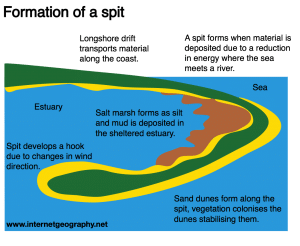Landforms of Coastal Deposition Flashcards
What is a bar?
Click to View the Answer
Click to View the Question
A bar is a ridge of sand or single that joins two headlands either side of a bay.
Find out more about landforms of coastal deposition.
What is a bar?
What is a sand dune?
Click to View the Answer
Click to View the Question
A sand dune is a small ridge or hill of sand found at the top of a beach, above the reach of the waves.
Find out more about sand dunes.
What is a sand dune?
Where do sandy beaches typically form?
Click to View the Answer
Click to View the Question
A sandy beach is usually formed in a sheltered bays, where low energy, constructive waves transport material onto the shore.
Find out more about landforms of coastal deposition.
Where do sandy beaches typically form?
What is an off-shore bar?
Click to View the Answer
Click to View the Question
An offshore bar is a raised area of seabed that is found offshore.
Find out more about landforms of coastal deposition.
What is an off-shore bar?
Produce an annotated diagram to show the main features of a spit.
Click to View the Answer
Click to View the Question
Find out more about landforms of coastal deposition.
Produce an annotated diagram to show the main features of a spit.

